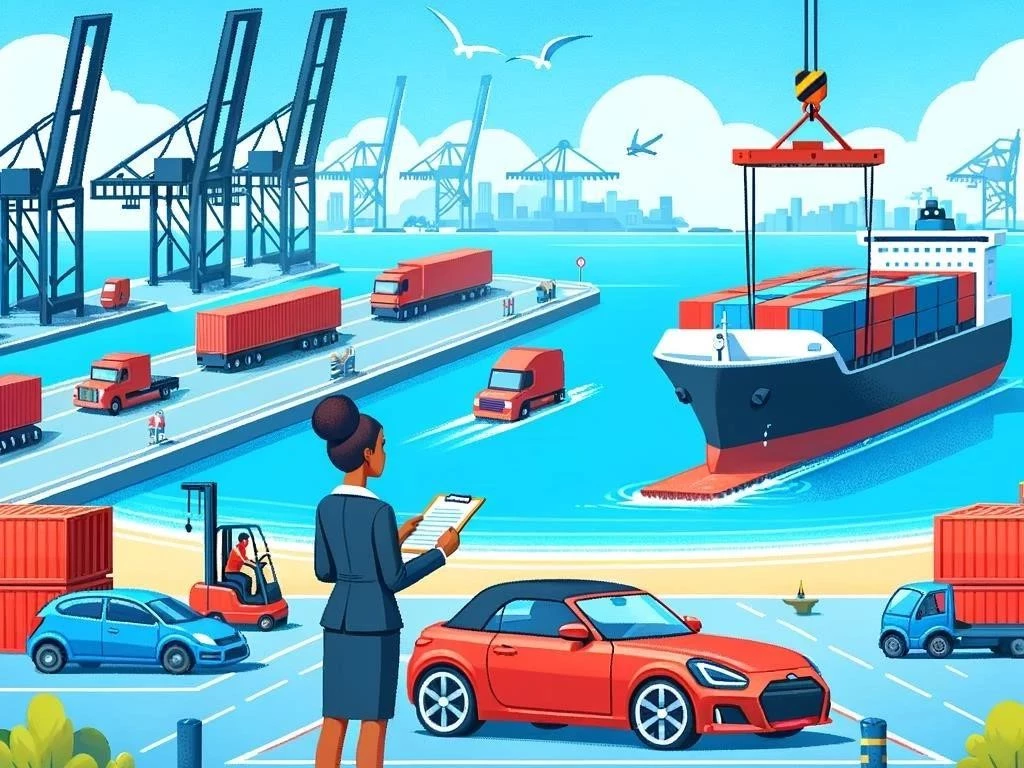How to Ship Your Car to Hawaii
Shipping your car to Hawaii involves understanding car shipping options, selecting reliable shipping companies, comparing quotes, and preparing your vehicle for transport meticulously.
Understanding Car Shipping
Car shipping is the process of transporting vehicles from one location to another, often involving specialized auto shipping services and logistics solutions tailored for various destinations.
1.1 What is Car Shipping?
Car shipping refers to the process of transporting vehicles from one location to another, especially when moving to distant locations like Hawaii. This service is essential for individuals needing vehicle relocation without driving long distances. Various auto shipping services offer different options, including open and enclosed transport. Companies provide shipping quotes based on factors like vehicle size, distance, and shipping method. Understanding the logistics solutions involved in car shipping helps customers navigate the complexities of port procedures and shipping regulations. With international shipping, additional considerations like car import taxes and duties come into play. Ultimately, car shipping ensures safe and efficient vehicle delivery to the desired destination.
1.2 Importance of Auto Shipping Services
Auto shipping services play a crucial role in facilitating vehicle relocation, especially when transporting cars to Hawaii. These services provide customers with specialized expertise in handling the complexities of car shipping, including compliance with shipping regulations and navigating port procedures. By utilizing professional shipping companies, individuals can ensure safe and timely delivery of their vehicles. Additionally, auto shipping services offer various freight options, such as container shipping and open transport, catering to diverse customer needs. With competitive shipping quotes, customers can make informed decisions regarding transportation costs. Ultimately, these services provide peace of mind, ensuring vehicles arrive in excellent condition while minimizing stress for the owner.
Overview of Hawaii Transport
Hawaii transport encompasses unique challenges and requirements for shipping vehicles, ensuring compliance with local regulations and ensuring safe, efficient delivery across the islands.
2.1 Unique Aspects of Shipping to Hawaii
Shipping to Hawaii involves unique considerations that differ from mainland transport. First, the geographic isolation of the islands requires specialized ocean shipping methods. Vehicles are typically transported via car carriers or container shipping, ensuring safety during transit. Additionally, understanding local shipping regulations is essential for compliance and smooth vehicle import. Weather conditions can also impact shipping schedules, necessitating flexibility in planning. Furthermore, transportation costs may vary significantly due to fuel prices and shipping logistics. It’s crucial to choose experienced shipping companies familiar with Hawaii transport to navigate these challenges effectively. Overall, preparing adequately for these unique aspects ensures a hassle-free experience when relocating vehicles to Hawaii.
2.2 Benefits of Using Hawaii Car Transport
Utilizing Hawaii car transport services offers numerous advantages for vehicle relocation. First, professional shipping companies possess specialized knowledge of local regulations, ensuring compliance throughout the process; This expertise minimizes potential delays or complications, allowing for smooth vehicle delivery. Additionally, these services often provide various freight options, including open and enclosed transport, catering to individual needs and budgets. Using experienced auto logistics providers also enhances vehicle safety during transit, protecting against damage. Furthermore, shipping companies can offer competitive shipping quotes, helping customers manage transportation costs effectively. Overall, choosing Hawaii car transport simplifies the relocation process, providing peace of mind and reliability for individuals moving their vehicles to the islands.
Vehicle Relocation Options
When shipping your car to Hawaii, you can choose from various relocation options, including open transport, enclosed transport, and container shipping for enhanced protection.
3.1 Open vs. Enclosed Transport
When choosing a transportation method for shipping your car to Hawaii, understanding the differences between open and enclosed transport is essential. Open transport is the most common and cost-effective option, where vehicles are loaded onto open car carriers, exposed to the elements. This method is suitable for standard vehicles and offers faster shipping times. In contrast, enclosed transport provides a higher level of protection, as vehicles are transported in fully enclosed trailers. This option is ideal for luxury, classic, or vintage cars that require extra care during transit. While enclosed transport typically incurs higher costs, it offers peace of mind for owners prioritizing vehicle safety and protection.
3.2 Container Shipping for Vehicles
Container shipping for vehicles is a secure and reliable method for transporting cars to Hawaii. This service involves placing the vehicle inside a shipping container, providing optimal protection against environmental factors and potential damage during transit. Container shipping is particularly beneficial for luxury, vintage, or high-value vehicles, as it minimizes exposure to elements like rain, wind, and debris. Additionally, this method allows for the shipping of personal belongings alongside the vehicle, maximizing space utilization. While container shipping may come with higher costs compared to open transport, its added security and peace of mind make it a popular choice for those prioritizing vehicle safety during relocation.
Choosing the Right Shipping Company
Selecting the right shipping company is crucial for successful vehicle transport, ensuring reliability, proper handling, competitive quotes, and compliance with regulations throughout the shipping process.
4.1 Key Factors to Consider
When selecting a shipping company for transporting your car to Hawaii, several key factors should be considered. First, evaluate their experience and reputation in the industry, as established companies are more likely to provide reliable service. Ensure they offer appropriate auto shipping services, including open and enclosed transport options, based on your vehicle’s needs. Additionally, check for proper licensing and insurance coverage, as this protects your vehicle during transit. Compare shipping quotes from multiple companies to find the best value while considering additional services like tracking and customer support. Finally, read customer reviews to gauge overall satisfaction and make an informed decision for your vehicle relocation.
4.2 Comparing Shipping Quotes from Different Companies
Comparing shipping quotes from various companies is essential for finding the best deal for transporting your car to Hawaii. Start by gathering quotes from at least three to five reputable shipping companies. Ensure that each quote includes all relevant costs, such as transportation fees, insurance, and any additional charges. Be cautious of unusually low quotes, as they may indicate subpar service or hidden fees. Look for details regarding the shipping method and estimated delivery times, as these factors can greatly influence your decision. Additionally, consider customer reviews and testimonials to assess the quality of service provided. Ultimately, a well-rounded comparison will help you choose the right shipping company.
Understanding Transportation Costs
Transportation costs for shipping your car to Hawaii depend on various factors, including vehicle type, shipping method, distance, and additional services offered by shipping companies.
5.1 Factors Affecting Cost of Car Freight
Several factors influence the cost of car freight when shipping your vehicle to Hawaii. First, the type of vehicle plays a significant role; larger or heavier vehicles generally incur higher shipping costs. The chosen shipping method, such as open transport versus enclosed transport, also affects pricing, with enclosed options typically being more expensive due to added protection. Additionally, the distance between the pickup location and the destination in Hawaii can impact transportation costs. Seasonal demand fluctuations may lead to price variations, so timing can be crucial. Finally, extra services like shipping insurance, tracking, and expedited delivery can also contribute to the overall cost, so evaluate all options carefully.
5.2 Hidden Fees in Shipping Regulations
When shipping your car to Hawaii, it’s essential to be aware of potential hidden fees that may arise from shipping regulations. Some companies might charge extra for port handling fees, which are costs associated with unloading and processing your vehicle at the destination port. Additionally, customs clearance fees may apply, particularly for international shipments, which can add to overall expenses. Insurance costs are another factor; while it’s advisable to have coverage, some companies may charge extra for it. Furthermore, there may be administrative fees for paperwork processing and inspection services. Carefully reviewing the shipping contract and asking questions can help uncover these hidden costs before finalizing arrangements.
Preparing Your Vehicle for Shipping
Properly preparing your vehicle for shipping ensures a smooth process. This includes cleaning, checking fluids, removing personal items, and addressing any mechanical issues beforehand.
6.1 Pre-Shipping Checklist
Preparing your vehicle for shipping to Hawaii requires a detailed pre-shipping checklist to ensure a smooth process. First, clean the interior and exterior of your car to facilitate inspection and identify any existing damage. Next, check all fluid levels, including oil, coolant, and brake fluid, ensuring they are topped off. Remove personal items and accessories, as these can be lost or damaged during transit. Additionally, disable alarms and secure loose parts to prevent issues during shipping. Inspect tire pressure and ensure that the vehicle is operational. Lastly, document the vehicle’s condition with photographs, as this will help address any concerns upon delivery, ensuring peace of mind throughout the process.
6.2 Importance of Shipping Insurance
Shipping insurance is a critical component when transporting your vehicle to Hawaii, providing essential protection against potential damage or loss during transit. Even with reliable shipping companies, accidents can happen, and unforeseen circumstances may arise. Having adequate insurance coverage ensures that you are financially protected in case of any unfortunate events. This coverage typically includes damages incurred during loading, transport, and unloading, giving you peace of mind throughout the shipping process. Additionally, it’s essential to review the insurance policies offered by the shipping company and consider purchasing additional coverage if necessary. Ultimately, shipping insurance safeguards your investment and helps you navigate potential risks associated with vehicle relocation.
Port Procedures for Car Shipping
Understanding port procedures is crucial when shipping your car to Hawaii, ensuring efficient processing, compliance with regulations, and smooth transitions during vehicle pickup and delivery.
7.1 Understanding Ocean Shipping Processes
Understanding the ocean shipping processes is vital for successfully transporting your car to Hawaii. Initially, vehicles are delivered to the designated shipping port, where they undergo inspection and documentation. Afterward, the vehicles are loaded onto specialized car carriers or into containers, depending on the chosen shipping method. During transit, the shipping company navigates complex maritime routes, ensuring compliance with international shipping regulations. Upon arrival at the Hawaiian port, customs clearance is required, involving inspections and paperwork verification. Finally, vehicles are unloaded and prepared for delivery to their respective destinations. Familiarizing yourself with these processes can help alleviate concerns and enhance your overall shipping experience.
7.2 Navigating Port Procedures in Hawaii
Navigating port procedures in Hawaii is crucial for a seamless vehicle shipping experience. Upon arrival, you’ll need to provide necessary documentation, including proof of ownership, shipping paperwork, and identification. Customs officials will inspect the vehicle to ensure compliance with local regulations and determine any applicable fees or taxes. It’s essential to be prepared for potential inspections, which may include emissions checks or safety compliance evaluations. Once cleared, you’ll receive instructions for picking up your vehicle. Familiarizing yourself with the specific port’s procedures and operating hours is beneficial, as this knowledge helps streamline the process and reduces delays, ensuring your vehicle reaches its destination promptly and efficiently.
Post-Shipping Steps
After shipping your car to Hawaii, ensure timely vehicle pickup, inspect for any damage, and complete necessary registration and title transfer processes to finalize relocation.
8.1 Vehicle Delivery Process
The vehicle delivery process is a crucial step after shipping your car to Hawaii. Upon arrival at the designated port, you will receive notification from the shipping company regarding your vehicle’s readiness for pickup. Make sure to gather all required documents, such as the bill of lading, identification, and any customs paperwork. Upon reaching the port, you will need to present these documents to the port authorities. They will conduct a final inspection of the vehicle before clearance. Once cleared, you can retrieve your car from the designated area. It’s essential to thoroughly inspect the vehicle for any damages and report issues immediately to the shipping company for resolution.
8.2 Inspecting Your Car Upon Arrival
Inspecting your car upon arrival in Hawaii is vital to ensure it sustained no damage during shipping. Begin by examining the exterior for scratches, dents, or paint chips. Check all windows and mirrors for cracks or breaks. Next, inspect the tires for any signs of damage or irregular wear. Open the hood to ensure fluid levels are adequate and that there are no leaks. Additionally, start the engine and listen for any unusual noises, confirming that the vehicle operates smoothly. Document any damages with photographs, as this evidence will be essential if you need to file a claim with the shipping company. Addressing issues promptly protects your investment.
International Shipping Considerations
When shipping your car to Hawaii internationally, be aware of import regulations, taxes, necessary documentation, and potential modifications required to comply with local vehicle standards.
9.1 Import Regulations for Cars in Hawaii
Import regulations for cars in Hawaii are crucial to understand before shipping your vehicle. All vehicles imported must comply with the Environmental Protection Agency (EPA) and Department of Transportation (DOT) standards. This often requires modifications to meet local emissions and safety regulations. Additionally, you must provide specific documentation, including the vehicle’s title, proof of ownership, and a bill of lading from the shipping company. Customs duties and taxes may apply based on the vehicle’s value, so being prepared for these costs is essential. Failure to comply with these regulations can result in delays, fines, or even denial of entry for your vehicle into Hawaii.
9.2 Understanding Car Import Taxes and Duties
Understanding car import taxes and duties is essential when shipping your vehicle to Hawaii. Import taxes are typically based on the vehicle’s value, including any modifications made to meet local regulations. These taxes can vary significantly depending on the vehicle’s age, type, and condition. Additionally, you may encounter customs duties, which are fees charged for processing your vehicle through customs. It’s important to research and estimate these costs beforehand to avoid unexpected financial burdens. Providing accurate documentation, such as purchase receipts and vehicle appraisals, can help streamline the customs process. Consulting with a shipping company experienced in international transport can also provide valuable insights into potential taxes and duties.
Auto Logistics Solutions
Auto logistics solutions streamline the process of shipping your vehicle to Hawaii, offering efficient transportation options, expert handling, and comprehensive services to ensure timely delivery.
10.1 Choosing the Best Freight Options
Choosing the best freight options for shipping your car to Hawaii involves evaluating various transportation methods and their associated benefits. The two primary options are container shipping and roll-on/roll-off (RoRo) services. Container shipping provides added protection, as your vehicle is secured in a container, reducing exposure to environmental elements during transit. In contrast, RoRo service is often more cost-effective and allows for quicker loading and unloading. Consider the value of your vehicle when deciding; luxury or classic cars may warrant container shipping for added security. Additionally, assess the shipping company’s reputation, delivery timelines, and insurance coverage. A thorough comparison ensures you select the most suitable freight option for your needs.
10.2 Working with Cargo Services for Smooth Transport
Working with cargo services is essential for ensuring a smooth transport experience when shipping your car to Hawaii. These services specialize in vehicle logistics, offering expertise in navigating the complexities of shipping regulations, documentation, and customs requirements. When selecting a cargo service, consider their track record, customer reviews, and range of offered services. Effective communication is crucial; ensure they provide clear guidelines on preparation, shipping timelines, and potential costs. Additionally, inquire about tracking options to monitor your vehicle’s journey. A reputable cargo service will also offer insurance coverage, protecting your investment during transport. Building a solid relationship with your cargo provider enhances the overall shipping experience.
Traveling to Hawaii with Your Vehicle
Traveling to Hawaii with your vehicle involves careful planning, including shipping arrangements, understanding local transportation options, and ensuring compliance with state regulations for smooth travel.
11.1 Planning Your Trip with Vehicle Relocation
Planning your trip to Hawaii with vehicle relocation requires careful consideration of logistics and timelines. Start by determining your travel dates and when you want your car to arrive. It’s wise to book your shipping service well in advance, as space can be limited, especially during peak seasons. Ensure all necessary documents, such as the title and registration, are readily available to expedite the shipping process. Additionally, consider your arrival plans; knowing when and where you will pick up your vehicle can help avoid confusion. Finally, familiarize yourself with local driving regulations and road conditions in Hawaii to ensure a safe and enjoyable experience once your vehicle arrives.
11.2 Tips for Island Transport
Transporting your vehicle on the Hawaiian islands requires careful planning to ensure a smooth experience. First, familiarize yourself with local driving laws and regulations, as they may differ from those on the mainland. Always keep your vehicle’s registration and insurance information readily accessible in case of inspections. Plan routes ahead of time, taking into account scenic drives and popular attractions, but be prepared for variable road conditions. Utilize navigation apps to stay updated on traffic and weather conditions. Additionally, fuel stations can be sparse on certain islands, so keep your tank filled. Lastly, respect the natural environment and wildlife while driving, ensuring a safe and enjoyable journey.








